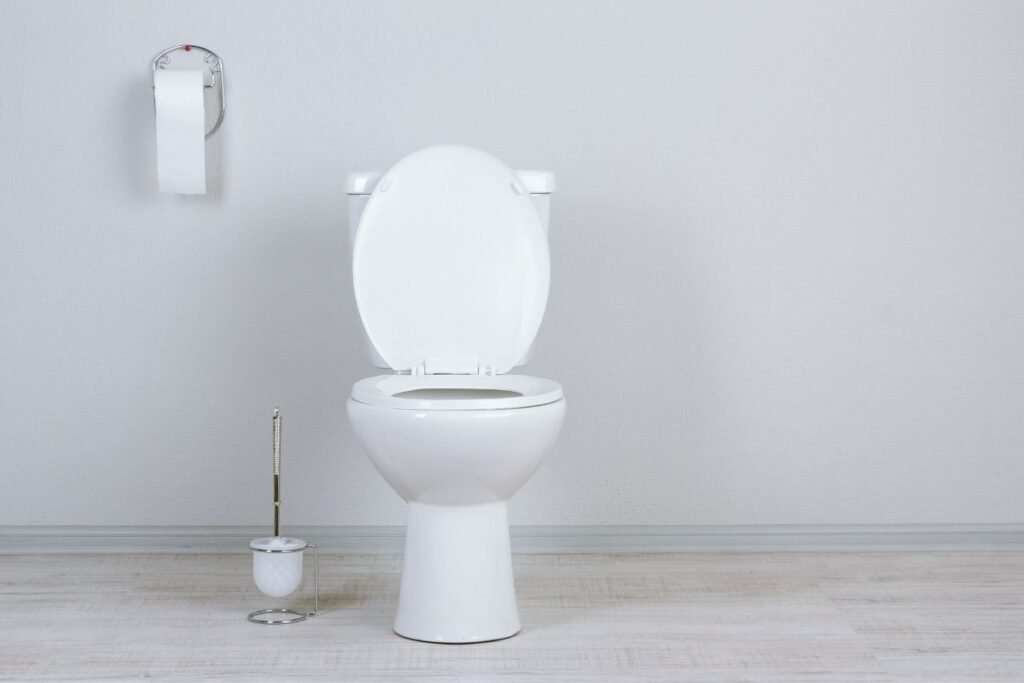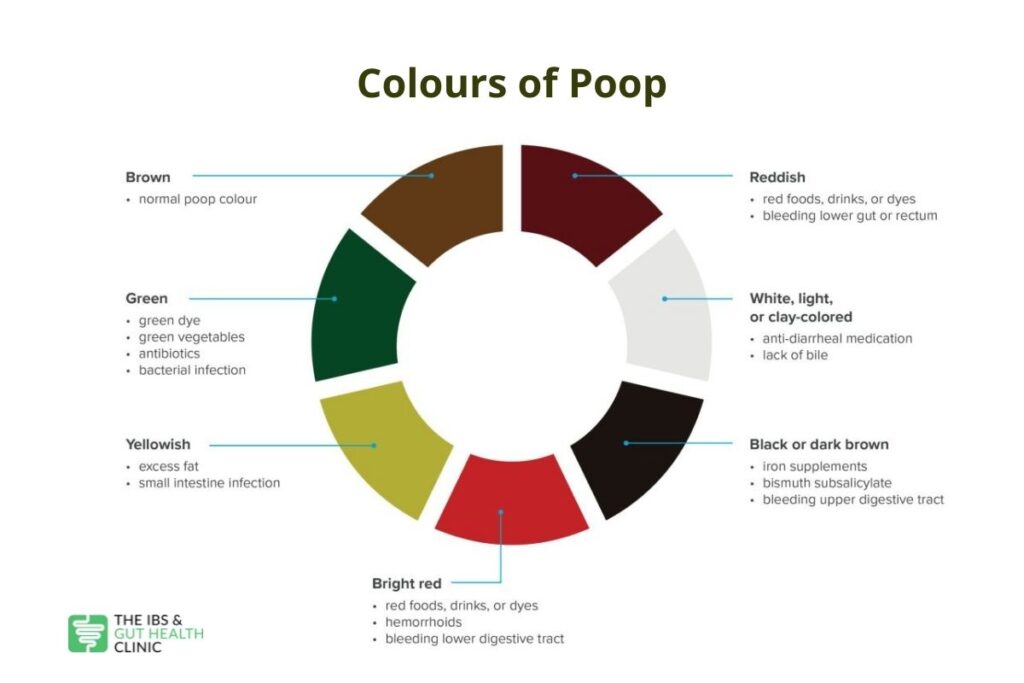
Stool Colour Changes and IBS
IBS (irritable bowel syndrome) can lead to a wide range of digestive symptoms.
While there are many causes and factors that contribute to the symptoms of IBS, changes in bowel symptoms can take place.
The symptoms of IBS can fluctuate. Gut issues such as bloating, altered bowel patterns (constipation or diarrhoea) as well as the colour of the stool.
While bloating and changes in bowel patterns can be painful and disruptive, changes in the colour of the stool can often be the most worrying.
A change in the colour of poop can be a concern, however, there are many factors that can contribute to this change.

What is a normal stool colour
There are 2 components that give poop its normal brown colour. These are bilirubin and bile.
Bilirubin is something that comes from the breakdown of old red blood cells.
As these cells are broken down in the liver the bilirubin is transported to the gallbladder, where it mixes with bile.
From the gallbladder, most of the bilirubin passes into the intestines. Once here it is broken down and degraded by bacteria before being passed out in the stool.
A normal stool colour can fluctuate depending on factors such as:
- Diet
- Medication
- Presence of digestive symptoms

These factors can lead to temporary alteration in the colour of the stool.
Nevertheless, alteration in the colour of stool can be worrying even when there is no cause for concern.
Also Read: IBS and Stomach Noises
The most common colours are various shades of brown. However, depending on diet the colour may change. This can be various shades of brown as well as:
- Green: possibly due to high intake of leafy green vegetables such as spinach
- Red: possibly due to high intake of beetroot [Source: NCBI]

IBS Stool Colour
For those with IBS, stool colour can be more of a concern. This can change depending on the presence/severity of symptoms.
It is common for those experiencing a flare up in symptoms such as bloating to potentially see a change in stool colour. Other factors that may contribute are dietary changes and medications.
Also Read: How Long Does IBS Last?
In IBS perhaps the most common change in stool is the change in consistency. This can be the stool being harder to pass and constipated or resulting in loose stool in the form of diarrhoea.
Due to the stool remaining in the colon for an extended period of time when constipated, this leads to more water being reabsorbed. This may darken the stool.
Alongside these changes the colour of the stool may be impacted. [Source: NCBI]
Green
Possible reasons:
- Green dye
- Green vegetables
- Antibiotics
- Bacterial infection
- Bile acid malabsorption
Yellow
Possible reasons:
- Excess fat
- Small intestine infection
Bright red
Possible reasons:
- Red foods, drinks or colourings
- Haemorrhoids
- Bleeding in the lower digestive tract
White or clay
Possible reasons:
- Anti-diarrheal medication
- Lack of bile
Black or dark brown
Possible reasons:
- Iron supplement
- Blooding in the upper digestive tract [Source:Pubmed]
Yellow stools and IBS
Yellow stools in IBS can be for a wide range of reasons.
It’s not always due to the same factors that are being the IBS symptoms.
Liver and gallbladder disorder
Conditions such as gallstones may reduce bile flow.
Since bile is an important enzyme to help digestive fats, low levels of bile may lead to excess fat remaining in the stool which may then lead to a yellow colour.
In some cases, this may turn the stool a grey colour. [Source:Pubmed]
Stress
Stress is a well-known factor that can contribute to IBS symptoms.
One main reason for this is that stress can speed up transit time leading to quicker bowel movements. This increased transit time will reduce our ability to break down and digest food [Source: NCBI].
Diet
Foods such as carrots and sweet potatoes as well as foods that contain high amounts of food colourings may also contribute to a yellow stool.
Typical Stool Colours
Changes in stool colour can vary depending on many factors.
Stool colour chart

Colours to Be Concerned About
While a change in stool colour does not always mean there is something to be concerned about, it may be wise to inform your GP if any of the following occur.
Bright red stools
This may indicate a bleed towards the end of the digestive tract, this may be commonly caused by haemorrhoids.
Black or dark brown stool
While this may be caused by certain medications (such as iron tablets) it may also indicate bleeding in the upper part of the digestive system.
Yellow stool
Yellow stool can be caused by dietary patterns however if the colour persists there may be other causes.
Yellow stool concerns
While a change in colour is not always a concern by itself speaking with a doctor may be advised if that change is accompanied by any of the following
- Temperature/fever
- Feeling faint/passing out
- Problem’s urinating (weeing)
- Problems breathing
- Mental changes such as confusion
- Pain in the right-sided upper abdomen
- Vomiting and nausea (6)[Source: NCBI]
Yellow stool causes
These additional symptoms may indicate an underlying issue that is contributing to the change in colour.
How often should you check?
Toilet habits may be seen as a taboo topic.
Due to this we may simply flush the toilet after passing a stool without giving it a second thought or look.
Checking the colour and consistency of the stool can be a helpful way to monitor bowel function.
Frequently Asked Questions:
Can IBS change stool colour?
IBS can lead to a wide range of changes in bowel function.
Commonly, those with IBS-D (irritable bowel syndrome with diarrhoea) may see the biggest changes in stool colour.
This is often due to:
- Increased transit time which leads to less time for food to be digested
- Increased transit time which leads to less time bile to be reabsorbed
Additionally, those with IBS-C D (irritable bowel syndrome with constipation) may have a stool a darker shade of brown.
This is likely due to an increase in fluid being reabsorbed in the large intestine. This often dries the stool leading to a stool that is darker in brown.[Source: NCBI]
What colour is poo with IBS?
The colour of poo can vary in IBS. This varies of factors such as:
- If there’s diarrhoea
- If there’s constipation
- If there is a bile in the stool [Source:NHS]
Does IBS cause ribbon like stools?
Ribbon like stools may be an issue in younger individuals. This can often be caused by a strong contraction on the colon that ‘squashes’ the stool.
By itself, this is not generally a symptom many would be concerned about. However, in the presence of other factors it may be a sign of something more serious. These other factors would include:
- Blood in the stool
- A family history of colon cancer
- Weight loss
- Low blood count
For those with IBS, a spasm or strong contraction in the colon is often the cause of a ribbon like stool. [Source: NCBI]
What do light coloured stools mean?
While the colour of a normal stool may vary across a range of shades of brown, this can mostly be due to diet.
Dramatic changes in stool colour would not be considered normal and may be something a doctor would like to investigate.
Light coloured stools would not be considered normal, and this can be an indication of an issue with the gallbladder, liver or pancreas.
The dark colour of stools is due to bile salts. These are released from the liver.
If the heath of the liver is compromised or is not producing enough bile the colour stool may become pale or lighter in colour. This may also be due to a blocked bile duct. [Source:Pubmed]
Conclusion
Fluctuations in stool colour can be normal and be due to many factors, most of which are not a cause for concern.
However, if the changes persist or occur frequently a conversation with a doctor may help to rule out illness and disease.






